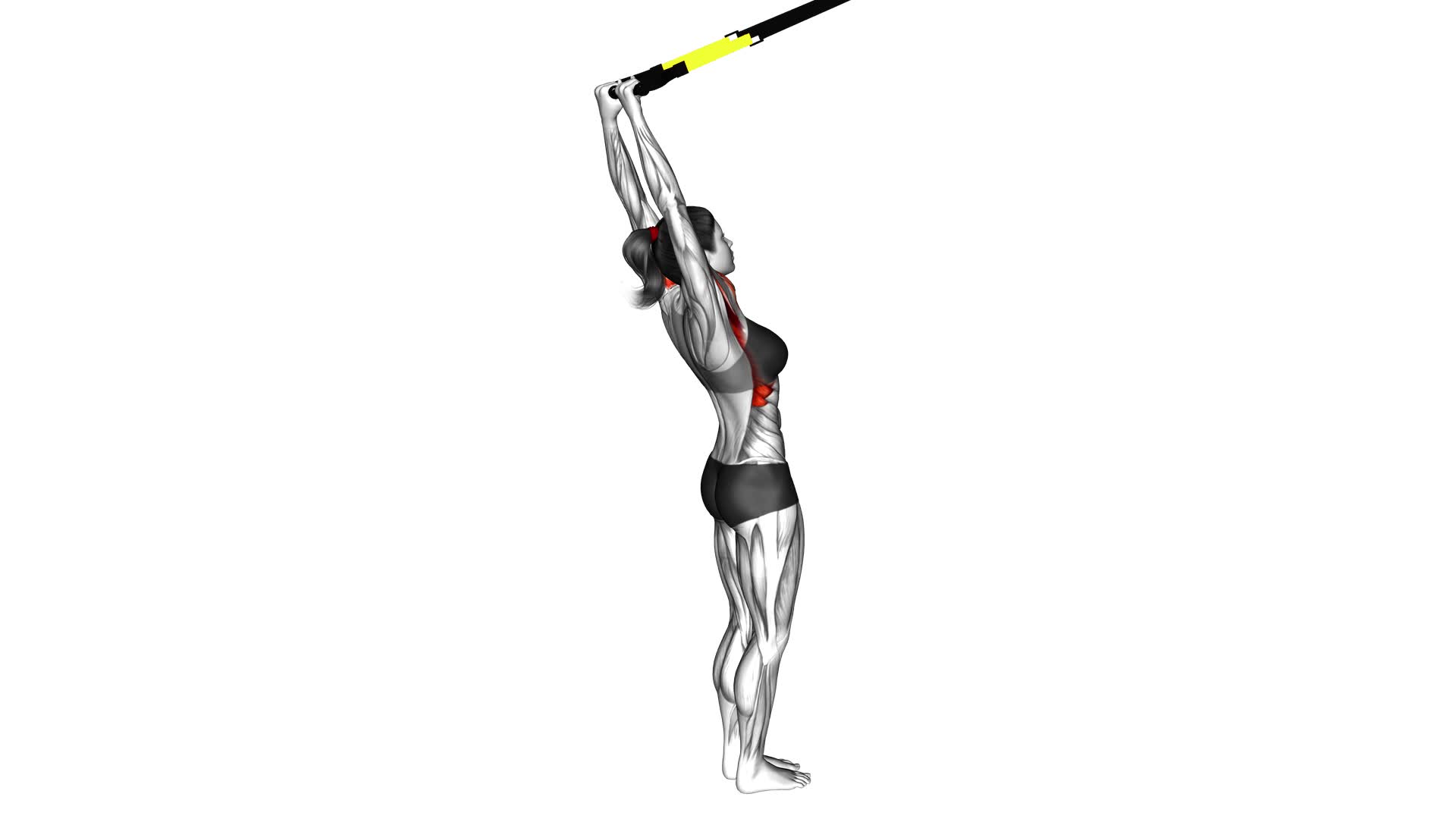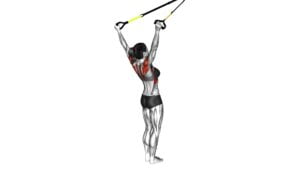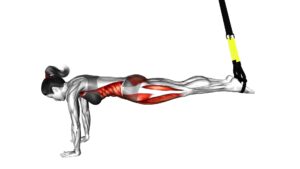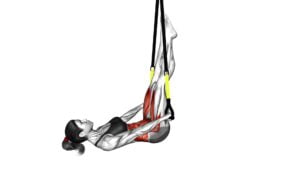Suspender Front Raise (female) – Video Exercise Guide & Tips

Are you looking for an effective exercise to strengthen and tone your upper body? Look no further than the suspender front raise!
Watch This Exercise Video
In this video exercise guide, we will show you the proper form and technique to perform this exercise correctly. We will also provide variations to challenge yourself and tips to get the most out of your workout.
Get ready to feel the burn and achieve your fitness goals with the suspender front raise!
Key Takeaways
- The Suspender Front Raise targets deltoid muscles in the shoulders.
- It strengthens and tones the deltoids.
- It improves shoulder stability and functionality.
- It engages muscles in the upper back and arms.
Benefits of the Suspender Front Raise
You can experience multiple benefits by incorporating the Suspender Front Raise into your workout routine. This exercise primarily targets the deltoid muscles, which are located in your shoulders. By performing the Suspender Front Raise, you can effectively strengthen and tone these muscles, helping to improve your overall shoulder stability and functionality.
Additionally, this exercise also engages the muscles in your upper back, including the trapezius and rhomboids, as well as the biceps in your arms.
To perform the Suspender Front Raise, you'll need suitable equipment such as resistance bands or dumbbells. These tools provide the necessary resistance to challenge your muscles and promote muscle growth. When using resistance bands, make sure to choose a band with appropriate tension to match your fitness level.
Proper form and technique are essential when performing the Suspender Front Raise. It's crucial to maintain a neutral spine, engage your core, and avoid any swinging or jerking movements. Keep your shoulders relaxed and focus on lifting your arms in a controlled manner, maintaining a slight bend in your elbows throughout the exercise.
Proper Form and Technique
To ensure proper form and technique during the Suspender Front Raise, maintain a neutral spine, engage your core, and focus on controlled arm movements while keeping your shoulders relaxed. This exercise primarily targets the deltoids, which are the muscles responsible for raising your arms in front of your body.
By maintaining a neutral spine, you ensure that your back is in a stable and aligned position, reducing the risk of injury. Engaging your core helps to stabilize your body and protect your lower back.
You should also focus on controlled arm movements to prevent any swinging or jerking motions, which can put unnecessary strain on your shoulder joints. Keeping your shoulders relaxed throughout the exercise allows for proper muscle activation and prevents tension from building up in your upper traps.
By following these guidelines, you can maximize the effectiveness of the Suspender Front Raise and minimize the risk of injury.
Now that you understand the proper form and technique for the Suspender Front Raise, it's time to explore some variations that will challenge yourself even further.
Variations to Challenge Yourself
To further challenge yourself, try incorporating variations of the Suspender Front Raise exercise.
By adding progression options to your routine, you can increase muscle activation and continue to push your limits.
One variation you can try is using heavier suspenders or adding ankle weights to increase the resistance. This will require your muscles to work harder and will help to build strength and definition.
Another option is to perform the exercise on an unstable surface, such as a balance board or a Bosu ball. This will engage your core muscles even more as they work to stabilize your body.
Additionally, you can try performing the exercise with a slower tempo, focusing on controlled and deliberate movements. This will increase the time under tension, further challenging your muscles.
Remember to always maintain proper form and technique while performing these variations to avoid injury.
Incorporating these progression options into your Suspender Front Raise routine will keep your workouts challenging and effective.
Common Mistakes to Avoid
One common mistake to avoid when performing the Suspender Front Raise exercise is improper shoulder alignment. It's important to keep your shoulders relaxed and down throughout the movement. Here are some common errors in suspender front raise technique and tips for improving form in the suspender front raise exercise:
- Raising the shoulders: Avoid shrugging your shoulders or lifting them towards your ears. This can put unnecessary stress on your neck and upper back. Instead, focus on keeping your shoulders down and away from your ears throughout the exercise.
- Using momentum: Swinging your arms or using momentum to lift the suspenders can take away from the effectiveness of the exercise. Instead, engage your shoulder muscles and lift the suspenders in a controlled manner. Focus on the muscles you're targeting and maintain a slow and controlled movement.
- Neglecting proper posture: Maintaining proper posture is crucial during the suspender front raise. Avoid arching your back or leaning forward. Stand tall with your core engaged and your spine neutral. This will help you target the correct muscles and prevent strain on your lower back.
Tips for Getting the Most Out of Your Workout
Get the most out of your workout by incorporating these three tips.
Firstly, it's essential to have a well-planned workout routine. Having a structured plan helps you stay focused and ensures that you're targeting all the necessary muscle groups. Consider consulting with a fitness professional who can create a personalized routine based on your fitness goals.
Secondly, vary your exercises to avoid plateauing. Your body adapts to repetitive movements, so incorporating different exercises helps challenge your muscles and keeps your workouts effective. Try incorporating strength training, cardio, and flexibility exercises into your routine to achieve a well-rounded workout.
Lastly, listen to your body and make adjustments as needed. If you're feeling fatigued or experiencing pain, it's crucial to give yourself rest days or modify your routine. Pushing yourself too hard can lead to injuries and setbacks. Remember, consistency is key, but it's also important to listen to your body's needs.
Frequently Asked Questions
How Many Calories Can I Expect to Burn While Doing the Suspender Front Raise Exercise?
When doing the suspender front raise exercise, you may wonder how many calories you can expect to burn. While I can't provide an exact number without the context of your individual factors, it's important to note that the number of calories burned during any exercise depends on various factors like your weight, intensity, and duration of the workout.
Additionally, modifications can be made for those with shoulder injuries to ensure safe and effective execution of the exercise.
Can I Perform the Suspender Front Raise Exercise if I Have a Shoulder Injury?
If you have a shoulder injury, it's important to modify the suspender front raise exercise to avoid further damage. This exercise primarily targets the shoulders, so performing it with an injury could exacerbate the problem.
Instead, focus on exercises that promote shoulder mobility and stability, such as gentle shoulder stretches and rotator cuff exercises.
Always consult with a healthcare professional or a certified trainer to determine the best course of action for your specific injury.
How Many Sets and Reps Should I Aim for When Incorporating the Suspender Front Raise Into My Workout Routine?
To get the most out of the suspender front raise exercise, it's important to know how many sets and reps to aim for. Incorporating this exercise into your workout routine can have several benefits, such as strengthening your shoulder and upper back muscles.
To achieve these benefits, it's recommended to perform 3-4 sets of 10-12 reps with proper form and technique. Remember to start with lighter weights and gradually increase as you become more comfortable and stronger.
Is It Necessary to Use Suspenders for the Suspender Front Raise, or Can I Use Alternative Equipment?
No, it isn't necessary to use suspenders for the suspender front raise. There are alternative equipment options available for this exercise.
You can use resistance bands, dumbbells, or even water bottles as a modification. These options provide similar benefits to the suspender front raise and can still effectively target your shoulder muscles.
Just make sure to choose a weight or resistance level that challenges you without compromising your form.
Are There Any Specific Muscles Targeted by the Suspender Front Raise Exercise That I Should Be Aware Of?
When performing the suspender front raise exercise, it's important to know the specific muscles that are targeted.
This exercise primarily targets the deltoids, which are the muscles in your shoulders. By engaging these muscles, you can improve shoulder strength and stability.
Additionally, the suspender front raise also engages the trapezius muscles in your upper back, helping to improve posture.
Incorporating this exercise into your routine can have various benefits for your upper body strength and overall fitness.
Conclusion
In conclusion, the suspender front raise is an effective exercise for targeting the front deltoids and improving overall shoulder strength. By maintaining proper form and technique, individuals can maximize the benefits of this exercise.
Adding variations to the workout routine can provide additional challenges and help prevent plateaus. Avoiding common mistakes and following tips for an optimal workout experience will ensure that you get the most out of your suspender front raise workout.

Author
Years ago, the spark of my life’s passion ignited in my mind the moment I stepped into the local gym for the first time. The inaugural bead of perspiration, the initial endeavor, the very first surge of endorphins, and a sense of pride that washed over me post-workout marked the beginning of my deep-seated interest in strength sports, fitness, and sports nutrition. This very curiosity blossomed rapidly into a profound fascination, propelling me to earn a Master’s degree in Physical Education from the Academy of Physical Education in Krakow, followed by a Sports Manager diploma from the Jagiellonian University. My journey of growth led me to gain more specialized qualifications, such as being a certified personal trainer with a focus on sports dietetics, a lifeguard, and an instructor for wellness and corrective gymnastics. Theoretical knowledge paired seamlessly with practical experience, reinforcing my belief that the transformation of individuals under my guidance was also a reflection of my personal growth. This belief holds true even today. Each day, I strive to push the boundaries and explore new realms. These realms gently elevate me to greater heights. The unique combination of passion for my field and the continuous quest for growth fuels my drive to break new ground.



